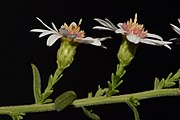| Symphyotrichum estesii | |
|---|---|

| |
| Conservation status | |
 Critically Imperiled (NatureServe) | |
| Scientific classification | |
| Kingdom: | Plantae |
| Clade: | Tracheophytes |
| Clade: | Angiosperms |
| Clade: | Eudicots |
| Clade: | Asterids |
| Order: | Asterales |
| Family: | Asteraceae |
| Tribe: | Astereae |
| Subtribe: | Symphyotrichinae |
| Genus: | Symphyotrichum |
| Subgenus: | Symphyotrichum subg. Virgulus |
| Section: | Symphyotrichum sect. Grandiflori |
| Species: | S. estesii |
| Binomial name | |
| Symphyotrichum estesii Semple | |

| |
| |
Symphyotrichum estesii is a species of flowering plant in the family Asteraceae, endemic to Coffee County, Tennessee. Commonly called May Prairie aster and Estes's aster, it is a perennial, herbaceous plant that may reach 30 to 85 centimeters (12 to 33 inches) in height. Its flowers have white ray florets and yellow disk florets. It is named in honor of botanist Dwayne Estes who discovered it in 2008.
Description
Symphyotrichum estesii is a perennial plant that blooms August through November. It grows from a long rhizome and forms colonies. Growing on one to several erect stems, the plants reach heights between 30 and 85 centimeters (12 and 33 inches). Its firm, hairy, green leaves range from lengths 5 to 6.6 cm (2 to 2+1⁄2 in) at the base to much shorter 1 to 7 millimeters on the higher stems. It has sometimes up to 50 white-rayed flower heads with yellow centers. Each head has approximately 9 to 17 ray florets surrounding 12 to 28 disk florets.
-
 Leaves and stem
Leaves and stem
-
 Leaves and stem
Leaves and stem
-
 Inflorescence showing bracts, involucres, and phyllaries
Inflorescence showing bracts, involucres, and phyllaries
-
 Larger inflorescence
Larger inflorescence
-
 Ray and disk florets
Ray and disk florets
-
 Growth habit in prairie
Growth habit in prairie
Chromosomes
Symphyotrichum estesii has a base number of x = 5 with an octaploid count of 40 determined by using meiosis from multiple pollen mother cells.
Taxonomy
Symphyotrichum estesii is classified in the subgenus Virgulus, section Grandiflori. It is named in honor of Austin Peay State University professor of biology and herbarium director Dwayne Estes who discovered it in 2008.
Distribution and habitat
Symphyotrichum estesii is found only in the May Prairie State Natural Area of Coffee County, Tennessee, within an area of less than 5 hectares (less than approximately 12 acres). May Prairie is located in the Eastern Highland Rim of central Tennessee.
Within May Prairie are an open grassland little bluestem community and a tallgrass prairie community, as well as some sedge meadows. This combined grassland community is surrounded by an oak forest that begins the oak barrens. The Symphyotrichum estesii population thrives in the hydroxeric soils in the open and sunny flat prairie sites. In semi-shaded areas nearer the woods, it can rarely be found.
Conservation
NatureServe lists it as Critically Imperiled (G1) worldwide.
Citations
- ^ NatureServe 2021.
- Semple 2019a.
- ^ Semple 2019b.
- ^ Semple 2019a, p. 1.
- ^ Semple 2019a, p. 7.
- ^ Semple 2019a, p. 9.
- Department of Environment & Conservation n.d.
References
- Department of Environment & Conservation (n.d.). "May Prairie Class II Natural-Scientific State Natural Area". www.tn.gov. Nashville: Tennessee State Government. Archived from the original on 18 October 2022. Retrieved 18 October 2022.
- NatureServe (8 January 2021). "Symphyotrichum estesii". explorer.natureserve.org. Arlington, Virginia. Retrieved 28 January 2021.
- Semple, J.C. (2019a). "Symphyotrichum estesii, a new species of virguloid aster from Tennessee (Asteraceae: Astereae)" (PDF). Phytoneuron. 2019 (36). Fort Worth, Texas: Guy L. Nesom: 1–10. ISSN 2153-733X. Retrieved 23 November 2020.
- Semple, J.C. (16 October 2019b). "Symphyotrichum estesii May Prairie Aster, Estes's Aster". www.uwaterloo.ca. Ontario. Archived from the original on 6 October 2021. Retrieved 26 October 2021.
| Taxon identifiers | |
|---|---|
| Symphyotrichum estesii | |